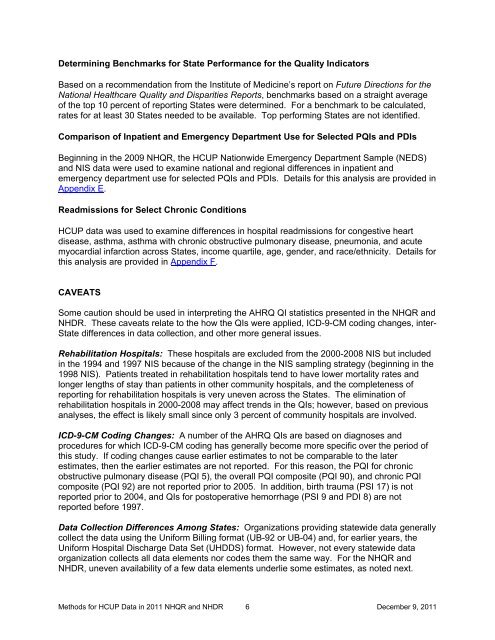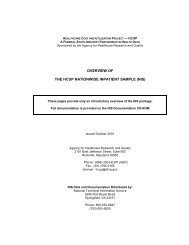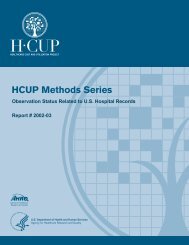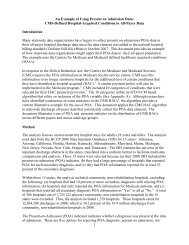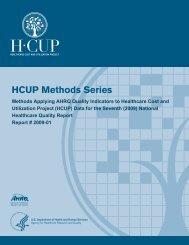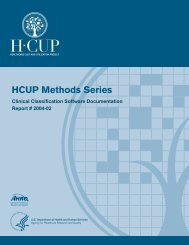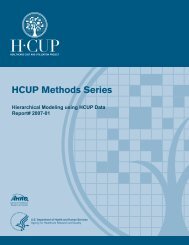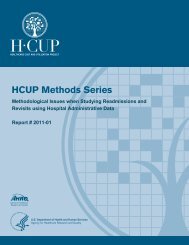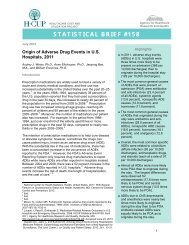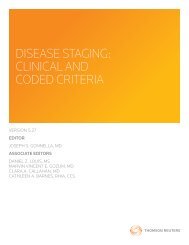Methods Applying AHRQ Quality Indicators to Healthcare ... - HCUP
Methods Applying AHRQ Quality Indicators to Healthcare ... - HCUP
Methods Applying AHRQ Quality Indicators to Healthcare ... - HCUP
Create successful ePaper yourself
Turn your PDF publications into a flip-book with our unique Google optimized e-Paper software.
Determining Benchmarks for State Performance for the <strong>Quality</strong> <strong>Indica<strong>to</strong>rs</strong>Based on a recommendation from the Institute of Medicine’s report on Future Directions for theNational <strong>Healthcare</strong> <strong>Quality</strong> and Disparities Reports, benchmarks based on a straight averageof the <strong>to</strong>p 10 percent of reporting States were determined. For a benchmark <strong>to</strong> be calculated,rates for at least 30 States needed <strong>to</strong> be available. Top performing States are not identified.Comparison of Inpatient and Emergency Department Use for Selected PQIs and PDIsBeginning in the 2009 NHQR, the <strong>HCUP</strong> Nationwide Emergency Department Sample (NEDS)and NIS data were used <strong>to</strong> examine national and regional differences in inpatient andemergency department use for selected PQIs and PDIs. Details for this analysis are provided inAppendix E.Readmissions for Select Chronic Conditions<strong>HCUP</strong> data was used <strong>to</strong> examine differences in hospital readmissions for congestive heartdisease, asthma, asthma with chronic obstructive pulmonary disease, pneumonia, and acutemyocardial infarction across States, income quartile, age, gender, and race/ethnicity. Details forthis analysis are provided in Appendix F.CAVEATSSome caution should be used in interpreting the <strong>AHRQ</strong> QI statistics presented in the NHQR andNHDR. These caveats relate <strong>to</strong> the how the QIs were applied, ICD-9-CM coding changes, inter-State differences in data collection, and other more general issues.Rehabilitation Hospitals: These hospitals are excluded from the 2000-2008 NIS but includedin the 1994 and 1997 NIS because of the change in the NIS sampling strategy (beginning in the1998 NIS). Patients treated in rehabilitation hospitals tend <strong>to</strong> have lower mortality rates andlonger lengths of stay than patients in other community hospitals, and the completeness ofreporting for rehabilitation hospitals is very uneven across the States. The elimination ofrehabilitation hospitals in 2000-2008 may affect trends in the QIs; however, based on previousanalyses, the effect is likely small since only 3 percent of community hospitals are involved.ICD-9-CM Coding Changes: A number of the <strong>AHRQ</strong> QIs are based on diagnoses andprocedures for which ICD-9-CM coding has generally become more specific over the period ofthis study. If coding changes cause earlier estimates <strong>to</strong> not be comparable <strong>to</strong> the laterestimates, then the earlier estimates are not reported. For this reason, the PQI for chronicobstructive pulmonary disease (PQI 5), the overall PQI composite (PQI 90), and chronic PQIcomposite (PQI 92) are not reported prior <strong>to</strong> 2005. In addition, birth trauma (PSI 17) is notreported prior <strong>to</strong> 2004, and QIs for pos<strong>to</strong>perative hemorrhage (PSI 9 and PDI 8) are notreported before 1997.Data Collection Differences Among States: Organizations providing statewide data generallycollect the data using the Uniform Billing format (UB-92 or UB-04) and, for earlier years, theUniform Hospital Discharge Data Set (UHDDS) format. However, not every statewide dataorganization collects all data elements nor codes them the same way. For the NHQR andNHDR, uneven availability of a few data elements underlie some estimates, as noted next.<strong>Methods</strong> for <strong>HCUP</strong> Data in 2011 NHQR and NHDR 6December 9, 2011


